Last Updated
24/10/2025
Ever wondered why some apps cost $5,000 to build while others hit six figures? That’s one of the most common questions businesses and startups ask when stepping into the app world. The truth is there’s no one-size-fits-all price tag for app development.
Building an app is not always simple. It can be challenging because of technical work, strong competition, strict rules, and limited budgets. That’s why many companies now choose to outsource app development to save time and money. But knowing the exact cost can still be confusing since most firms don’t share clear prices.
According to reports
The global mobile app market is expected to reach approximately $613 billion in revenue by 2025, with worldwide mobile app downloads projected to surpass 300 billion.
To help with that, Sunshine Digital Solutions has gathered real insights on app development costs and the factors that affect them. In this article, you’ll discover the true cost of creating an app in 2025, what influences the price the most, and the hidden costs to consider that many businesses often overlook.
The cost of developing a mobile app depends largely on its complexity, features, and the platform you choose. Below is a rough breakdown of average app development costs across five categories from simple MVPs to feature-rich enterprise apps. These estimates give you a clear idea of what to expect before starting your project.
| App Type | Estimated Cost | Description |
|---|---|---|
| Simple App | $3,000–$4,000 | Includes basic functions like sign-up, forms, and simple navigation. |
| Mid-size App | $4,000–$6,000 | Has moderate backend support, user login, and third-party integrations. |
| Large App | $8,000–$10,000 | Features advanced UI, multiple integrations, and real-time updates. |
| Complex App | $10,000–$11,000 | Uses AI, ML, or IoT with a strong backend and tight security. |
| Enterprise App | Starts from $15,000 | Built for big companies with high-end security and system integrations. |
The following are some key factors that affect the overall app development cost. Understanding these factors helps you plan your budget and make smart decisions for your project.
When developing an app, one of the biggest cost factors is the platform you choose: Android, iOS, web, or cross-platform. Each platform has different tools, programming languages, and testing requirements that affect time and budget.
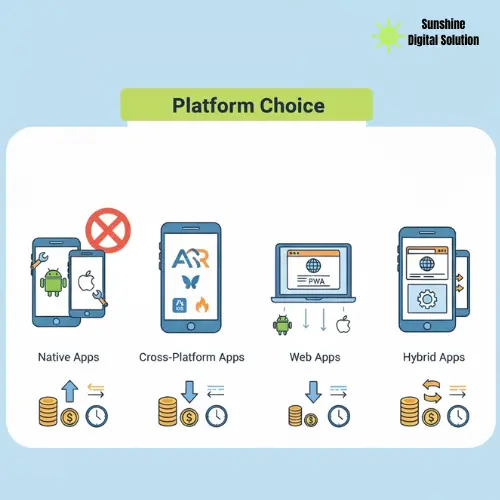
Choosing the right platform depends on your audience, budget, and timeline. For example, Android apps may cost more to develop due to extra testing for different devices, while iOS apps can be quicker and easier to optimize.
Design and user experience play a big role in how people connect with your app. A good design makes a strong first impression and ensures users can move around the app easily. During the UI/UX phase, designers create wireframes, mockups, and prototypes to plan the user journey and visualize each feature. The cost varies with complexity; simple layouts cost less, while advanced visuals require more work.
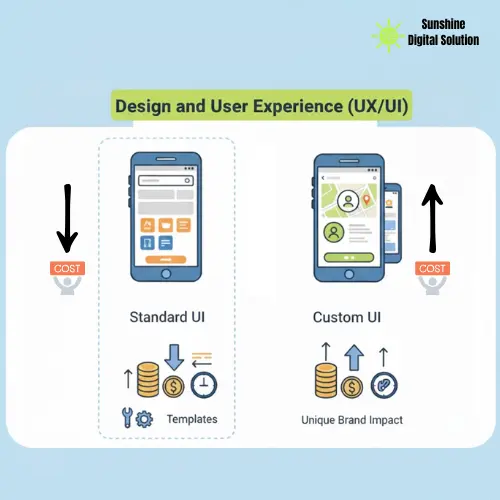
Usually, the design stage takes up 20–25% of the total app budget, costing around $3,000 to $30,000. Using low-code or no-code tools can help reduce costs with ready-made templates and drag-and-drop options. Companies often pick between Standard UI and Custom UI; Custom designs cost more but create a stronger brand impact.
For example, Starbucks’ mobile app uses a smooth and personalized design that makes ordering easy and keeps customers coming back.
The cost of app development depends on how big and skilled your team is. A typical team includes project managers, designers, developers, and testers. Larger or more experienced teams usually cost more than smaller ones or freelancers.
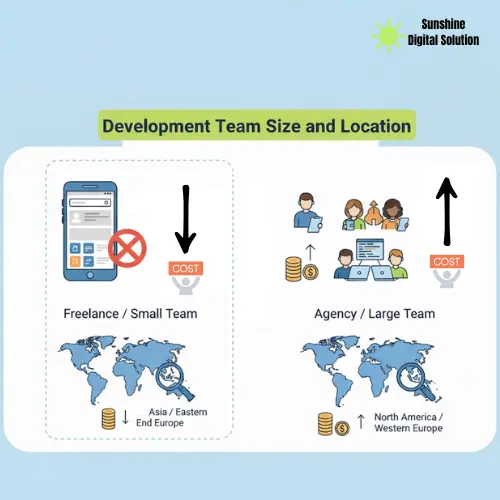
Location also affects pricing. Developers in regions like North America charge higher rates than those in Asia or Eastern Europe. Many companies outsource to areas with lower costs to save money while maintaining good quality.
The cost of an app highly depends on its features and how complex they are. Basic features like user login, simple dashboards, or contact forms are affordable and take less time to build. These usually cost between $3,000 – $4,000 and take around 3–6 weeks to complete.
Apps with moderate features, such as push notifications, payment gateways, or social media integration, cost more due to additional backend support and testing. These range from $3,500 – $5,000 and can take 6–10 weeks.
For advanced apps with high-end functions like AI, AR/VR, real-time syncing, or voice commands, development is far more time-consuming and expensive. Such apps require a strong backend, advanced security, and longer testing phases, significantly raising the overall cost.
The type of app and the industry it serves play a major role in determining its development cost. Each industry has unique needs, from user volume to data security, which affects time, complexity, and overall budget.
| App Category / Industry | Approximate Cost | Development Duration | Examples |
|---|---|---|---|
| Healthcare | $3,000 – $4,000 | 2 – 6 months | Patient record apps, chronic disease management |
| Education | $3,000 – $6,000 | 3 – 6 months | Online learning apps, virtual classrooms |
| Retail | $2,000 – $4,500 | 2 – 5 months | Shopping apps, local store platforms |
| Media & Entertainment | $5,000 – $6,000 | 3 – 6 months | Streaming, music, or video sharing apps |
| Social Media | $4,500 – $7,000 | 4 – 8 months | Chat, photo-sharing, or community apps |
| E-commerce | $6,000 – $9,000 | 5 – 9 months | Online shopping, retail, and payment apps |
| On-Demand | $7,000 – $11,000 | 6 – 10 months | Ride-sharing, delivery, or booking apps |
| Marketplace | $12,000 – $15,000 | 7 – 12 months | Rental or freelance service apps |
| IoT & Hardware | Starts from $10,000+ | 8 – 14+ months | Smart home, wearable, or connected car apps |
Modern apps use advanced technologies to boost performance and user experience. These innovations improve functionality but can also raise development costs and require expert skills.
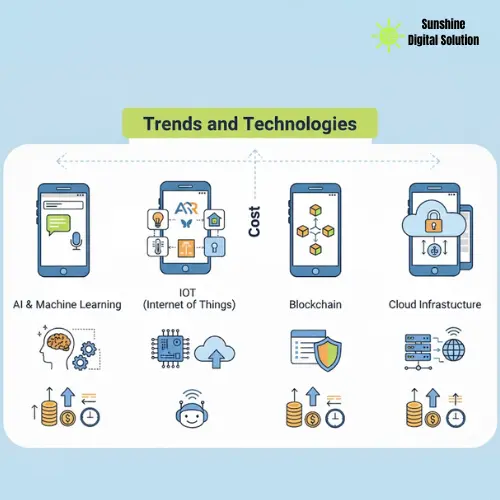
The technology stack, including languages, frameworks, and databases, strongly affects your app’s overall cost. Each tool comes with its own complexity, developer rates, and learning curve. Choosing the right combination ensures better scalability and performance.
The backend setup defines how smoothly your app runs behind the scenes. More complex systems require greater expertise and infrastructure, increasing development costs.
Every app needs a reliable backend to manage user data, servers, and real-time operations. Costs rise with added features, integrations, or advanced analytics.
Hosting and Server Costs
Cloud hosting ensures app reliability and scalability. Costs depend on traffic, storage, and the hosting plan selected.
Modern apps often rely on web-based APIs and third-party tools. Adding features like payment gateways, maps, or analytics raises both time and cost. If your app needs its own backend for managing functions, expect higher costs due to complex coding.
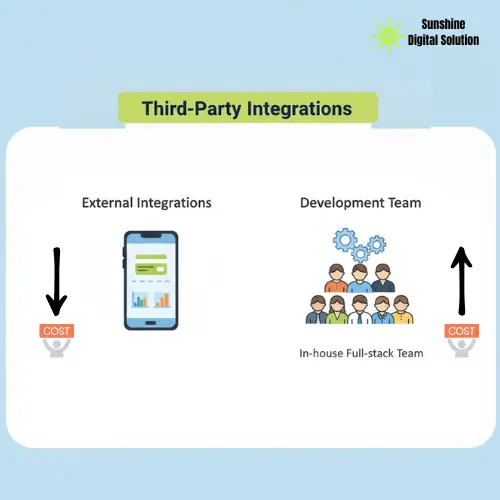
Building an in-house full-stack team is more expensive than outsourcing. Outsourcing helps reduce costs and ensures timely delivery since the agency handles project management and quality. However, it’s important to choose a reliable development partner.
Low-cost options, like some offshore agencies, might delay projects or lower the quality. Many small businesses end up rebuilding their apps, doubling the initial cost. Choosing an experienced near-shore team ensures on-time, high-quality results.
Building a mobile app follows a clear process that ensures quality, efficiency, and cost control. Here’s a breakdown of each stage:
Before development starts, study your audience, competitors, and trends. This helps confirm your app idea has real demand and defines a clear direction.
List the key features your app will include. Begin with essential ones for an MVP, then add advanced options later as user feedback grows.
Create a plan for your app’s growth and revenue. Decide how it will make money through ads, subscriptions, or purchases and outline your goals.
Decide whether to build for Android, iOS, or both. Then select suitable programming languages and frameworks to ensure high performance and easy growth.
Focus on user-friendly design. Wireframes and mockups help create a user-friendly layout that makes your app easy to navigate and visually appealing.
This is the core building stage. Developers code the front-end, back-end, and APIs, fusing all planned features to bring your idea to life.
Test your app for bugs, performance issues, and usability. Once it’s stable and polished, launch it on app stores for public use.
Keep your app running smoothly with regular updates, security fixes, and new features. Continuous improvement helps retain users and boost stability.
Developing a mobile app involves multiple stages, each with its own purpose and cost. Understanding how expenses are distributed across these phases helps businesses plan their budgets effectively and avoid unexpected costs later on.
This phase focuses on research, defining project goals, and outlining requirements. It typically costs 10–15% of the total budget.
Here, the app’s visual and interactive elements are created, including UI/UX, wireframes, and prototypes. This stage accounts for 20–25% of total development costs.
This is the most resource-heavy part of the process, where coding, backend setup, and integrations happen. It takes up 40–55% of the total budget.
QA ensures your app runs smoothly across devices, catching bugs before launch. It usually requires 15–25% of the total budget.
The final stage includes launching the app and ensuring it stays updated post-release. This typically costs 5–10% of the budget.
When developing an app, the visible costs, such as design and coding, are only part of the total investment. Several hidden or ongoing expenses are often overlooked but essential for an app’s long-term success. Below are key areas where extra costs can appear.
Even after launch, your app’s infrastructure needs ongoing care. Monthly costs range from $200 to $3,000+, depending on user load.
This includes cloud hosting, data storage, CDNs, and server maintenance. As your user base grows, so do these expenses, requiring sustainable server solutions like AWS or Google Cloud.
Maintenance is an ongoing commitment that typically costs 15–20% of the initial development budget annually. This covers bug fixes, security patches, design updates, and OS compatibility improvements.
Regular updates ensure your app stays secure, fast, and consistent with new devices and operating systems.
App stores charge fees to host and list your app.
Though small, these costs are essential for keeping your app available to users worldwide.
A great app needs visibility. Marketing costs can equal or go over your initial development cost, often 50–100% annually. This includes app store optimization (ASO), paid ads, PR campaigns, and social media promotions.
Without marketing, even the most innovative apps struggle to reach their audience.
Security is compulsory and can add $5,000 to $10,000+, depending on the app’s complexity.
This includes encryption, penetration testing, and regular security audits.
Investing in protection early prevents costly breaches and builds user trust.
Legal protection ensures your app complies with privacy laws and intellectual property rights. Costs can range from $1,000 for basic legal work to $50,000+ for complex agreements.
Covering licenses, contracts, and data compliance early can prevent future disputes and penalties.
Below are examples of popular apps that transformed user experience across different industries. While exact figures are confidential, these are estimated costs for creating apps with similar core features and complexity.
Spotify (Music Streaming App)
Spotify revolutionized how users enjoy music with streaming, playlist creation, and smart recommendations. It blends free and premium models for convenient listening.
Netflix (Video Streaming App)
Netflix transformed entertainment with its vast content library, streaming, and personalized recommendations across devices.
Uber (Ride-Hailing App)
Uber set the standard for on-demand transport, linking passengers and drivers in real time with GPS tracking and cashless payments.
Amazon (E-Commerce & Marketplace App)
Amazon dominates online retail through advanced search filters, one-click payments, AI-driven recommendations, and vast inventory management.
Instagram (Photo & Video Sharing App)
Instagram blends visuals, reels, messaging, and e-commerce features, becoming a powerful tool for brands and creators alike.
Tinder (Dating App)
Tinder made dating easy with its “swipe” system, location-based matching, and chat features that connect people instantly.
Developing a mobile app can be costly, but smart planning and strategies can significantly bring down expenses without compromising quality. Below are key approaches businesses can follow to optimize their app development budgets.
Focus on building a simplified version of your app with only the most essential features. An MVP helps test your idea in the market, gather user feedback, and validate demand before investing in full-scale development. This approach saves both time and money while reducing the risk of failure.
Instead of creating separate apps for iOS and Android, use frameworks like Flutter, React Native, or Xamarin. These allow you to build one codebase that works across multiple platforms, cutting development time and overall costs by up to 40%.
Hiring offshore or nearshore development teams can drastically lower costs compared to maintaining an in-house team. Outsourcing also gives you access to specialized expertise, faster project delivery, and flexibility in expanding your team as needed.
Start with the most impactful and business-critical features first. Avoid overloading your app with unnecessary functions at the initial stage. Once your app gains momentum and user feedback, you can gradually introduce advanced features in later versions.
At Sunshine Digital Solutions, we create cost-effective, high-quality mobile apps designed to grow your business. From concept to launch, our team focuses on building user-friendly, scalable, and engaging apps that deliver real results without exceeding your budget.
With expert developers, clear processes, and reliable support, we make app development simple, efficient, and affordable. Ready to bring your app idea to life? Let’s build something remarkable together.
Partner with a team that makes your ideas impactful.

Sunshine
Digital Solutions
Full-service marketing by Sunshine Digital Solutions. We offer website & app development, AI, SEO, web content & blogging, UI/UX, and video production services from Washington to all around the globe!
